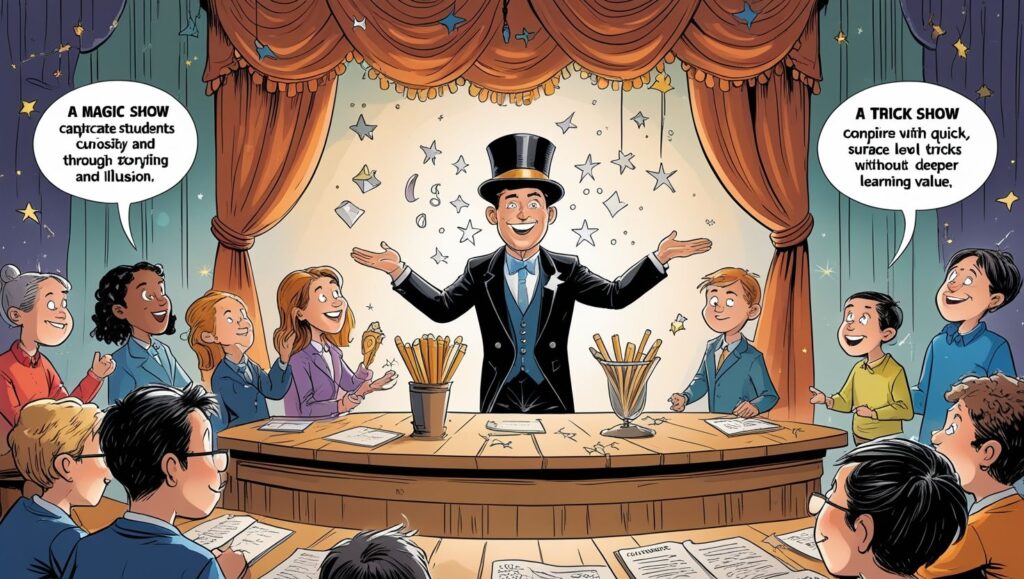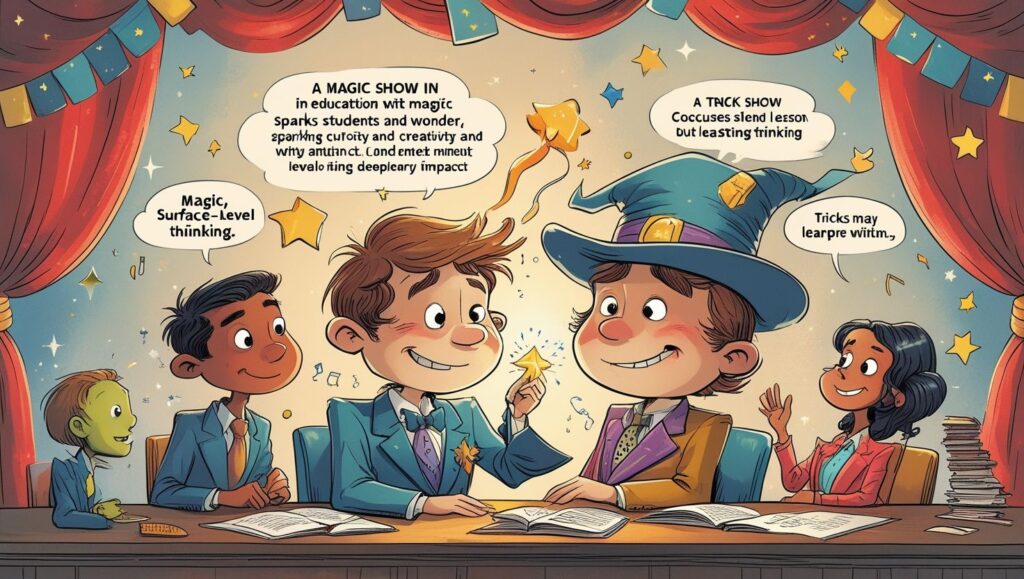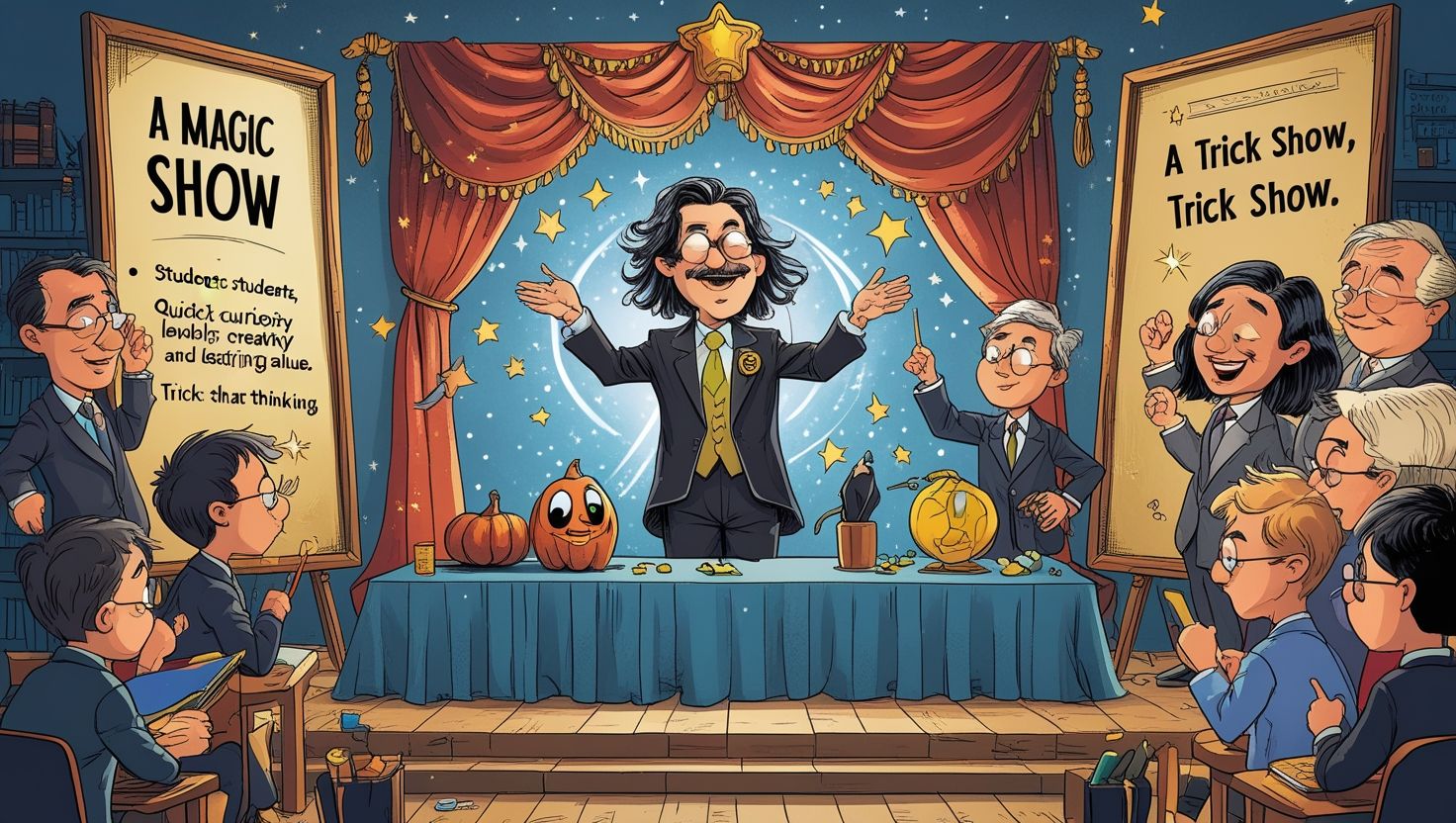Introduction
Magic Show vs. Trick Show in Education, In the evolving landscape of educational methodologies, unconventional approaches are increasingly being recognized for their potential to enhance learning experiences. Among these, magic shows and trick shows have emerged as innovative tools to engage students, stimulate curiosity, and foster a dynamic learning environment. While both involve elements of surprise and entertainment, they differ in execution, intent, and educational impact. Magic shows, often characterized by illusions and theatrical performances, aim to captivate audiences and evoke wonder. Trick shows, on the other hand, focus on puzzles, challenges, and demonstrations that encourage analytical thinking and problem-solving. Understanding the nuances between these two can help educators integrate them effectively into curricula to maximize student engagement and learning outcomes. This article delves into the definitions, differences, and educational implications of magic and trick shows, providing insights into how each can be leveraged to enrich the educational experience.
Understanding Magic Shows in Education
Magic shows in educational contexts are performances that utilize illusions, sleight of hand, and storytelling to convey concepts and captivate student interest. These shows are designed not merely for entertainment but to create memorable learning experiences that can reinforce academic content. For instance, a magician might use a disappearing act to explain the concept of conservation of mass in physics or employ card tricks to teach probability in mathematics. The visual and interactive nature of magic can make abstract concepts more tangible, aiding in comprehension and retention. Moreover, magic shows can stimulate imagination and creativity, encouraging students to think beyond conventional boundaries. They also provide opportunities for students to develop presentation and communication skills, especially when they are involved in performing tricks themselves. By integrating magic into lessons, educators can create an engaging atmosphere that fosters curiosity and a love for learning. However, it’s essential to ensure that the magical elements are directly tied to educational objectives to maintain academic rigor.
Exploring Trick Shows in Education
Trick shows, distinct from magic shows, focus on puzzles, brainteasers, and demonstrations that challenge students’ cognitive abilities. These shows aim to develop critical thinking, problem-solving, and analytical skills by presenting scenarios that require logical reasoning to decipher. For example, a trick show might involve a series of mathematical puzzles that students must solve collaboratively, promoting teamwork and communication. Unlike magic shows, which often rely on the element of surprise and illusion, trick shows are transparent in their intent to challenge and educate. They encourage students to question, hypothesize, and test their understanding, aligning closely with scientific inquiry methods. Incorporating trick shows into education can also help identify students’ learning styles and areas where they may need additional support. Furthermore, these shows can be tailored to various subjects, including mathematics, science, and language arts, making them versatile tools for educators. By engaging students in active problem-solving, trick shows can enhance cognitive development and foster a growth mindset.

Comparative Analysis: Magic vs. Trick Shows
While both magic and trick shows serve as engaging educational tools, their approaches and impacts differ significantly. Magic shows primarily aim to inspire and captivate, using illusions to make learning memorable. They are particularly effective in introducing new concepts or sparking interest in a subject. Trick shows, conversely, focus on developing critical thinking and problem-solving skills through challenges that require active participation. They are more analytical, encouraging students to delve deeper into content and apply knowledge practically. In terms of educational outcomes, magic shows are beneficial for enhancing creativity, imagination, and engagement, while trick shows are instrumental in building logical reasoning and cognitive skills. The choice between the two should align with the specific learning objectives and the needs of the student cohort. In some cases, a combination of both can provide a balanced approach, catering to diverse learning styles and fostering a comprehensive educational experience. Educators should consider the content, context, and desired outcomes when integrating these shows into their teaching strategies.
Implementing Magic Shows in Curriculum
Integrating magic shows into the curriculum requires careful planning to ensure they align with educational goals. Educators can collaborate with professional magicians or train to perform simple tricks themselves, embedding them into lessons to illustrate specific concepts. For instance, a science teacher might use a levitation trick to discuss principles of magnetism, or a history teacher could employ storytelling magic to bring historical events to life. It’s crucial to deconstruct the magic after the performance, guiding students to understand the underlying principles and relate them to the subject matter. This approach transforms passive entertainment into active learning. Additionally, encouraging students to learn and perform magic tricks can enhance their confidence, communication skills, and understanding of the content. Assessments can include presentations or written explanations of the tricks, evaluating both comprehension and creativity. By thoughtfully incorporating magic into lessons, educators can create a dynamic and immersive learning environment that resonates with students.
Incorporating Trick Shows into Learning
Trick shows can be seamlessly integrated into educational settings by designing activities that challenge students to solve problems, decipher codes, or unravel puzzles. These activities can be aligned with curriculum standards and tailored to various difficulty levels to accommodate diverse learners. For example, in a mathematics class, students might engage in a trick show involving number patterns or logic puzzles, promoting analytical thinking. In language arts, riddles and word games can enhance vocabulary and comprehension skills. Educators can facilitate these shows by presenting the challenges and guiding discussions that explore different solution strategies. This collaborative approach encourages peer learning and communication. Moreover, incorporating technology, such as interactive apps or online platforms, can modernize trick shows and appeal to digital-native students. Assessment can involve reflective journals, group presentations, or creating original puzzles, allowing students to demonstrate their understanding creatively. By embedding trick shows into the curriculum, educators can foster a stimulating environment that promotes critical thinking and problem-solving.

Benefits of Magic and Trick Shows in Education
Both magic and trick shows offer a plethora of benefits when integrated into educational contexts. Magic shows can enhance student engagement, making lessons more memorable and enjoyable. They stimulate imagination and creativity, encouraging students to think beyond traditional frameworks. Additionally, performing magic can build confidence and improve communication skills. Trick shows, on the other hand, develop critical thinking, logical reasoning, and problem-solving abilities. They promote active learning, requiring students to engage directly with content and apply knowledge practically. Both types of shows can cater to various learning styles, providing visual, auditory, and kinesthetic experiences. They also foster collaboration and teamwork, as students often work together to understand or perform tricks. Furthermore, these shows can break the monotony of traditional teaching methods, re-energizing the classroom atmosphere. By incorporating magic and trick shows, educators can create a holistic learning environment that nurtures cognitive, emotional, and social development.Tes+1Vanishing Inc. Magic+1
Challenges and Considerations
While the integration of magic and trick shows into education offers numerous benefits, it also presents certain challenges. One primary concern is ensuring that these activities align with curriculum objectives and do not detract from essential content. Educators must carefully design and implement shows to reinforce, rather than replace, academic learning. Time constraints within the school schedule can also limit the feasibility of incorporating such activities regularly. Additionally, not all educators may feel confident in performing or facilitating magic or trick shows, necessitating professional development or collaboration with specialists. Resource availability, such as materials and space, can further impact implementation. Moreover, it’s essential to consider student diversity, ensuring that shows are inclusive and sensitive to cultural and individual differences. Evaluating the effectiveness of these methods can be challenging, requiring innovative assessment strategies. Despite these challenges, with thoughtful planning and execution, magic and trick shows can be valuable additions to educational practices.
Case Studies and Success Stories
Numerous educational institutions have successfully integrated magic and trick shows into their curricula, yielding positive outcomes. For instance, a primary school in Kent, UK, implemented magic workshops to enhance students’ speaking and listening skills. The headteacher reported improved communication abilities and increased confidence among students. In another case, a science teacher used magic tricks to demonstrate chemical reactions, resulting in heightened student interest and better understanding of complex concepts. Similarly, a mathematics department organized trick shows involving logic puzzles and problem-solving tasks, leading to improved analytical skills and teamwork among students. These examples illustrate the potential of magic and trick shows to enrich educational experiences. They also highlight the importance of aligning these activities with learning objectives and tailoring them to student needs. By sharing best practices and success stories, educators can learn from each other and explore innovative ways to engage students through magic and trick shows.
Future Perspectives
As education continues to evolve, incorporating diverse and creative methodologies becomes increasingly important. Magic and trick shows represent innovative approaches that can complement traditional teaching methods, catering to various learning styles and needs. With advancements in technology.
Conclusion:
In conclusion, both magic shows and trick shows offer unique and valuable contributions to the field of education. Magic shows, with their enchanting illusions and storytelling, are powerful tools for sparking imagination, enhancing engagement, and creating memorable learning experiences. They are particularly effective in introducing new concepts and inspiring curiosity in students. Trick shows, by contrast, emphasize critical thinking, logic, and problem-solving through challenging tasks and interactive puzzles. They actively involve students in the learning process, strengthening cognitive development and analytical skills.
While distinct in approach, both methods share the common goal of enriching education beyond traditional classroom practices. Their effectiveness depends on thoughtful integration into the curriculum, alignment with learning objectives, and sensitivity to students’ diverse needs. Educators can maximize their impact by blending both approaches—using the wonder of magic to inspire and the rigor of trick-based challenges to deepen understanding.
Ultimately, when used appropriately, magic and trick shows can transform classrooms into vibrant spaces of exploration, creativity, and intellectual growth, making learning an enjoyable and lifelong adventure for students.

Şile su kaçak tespiti Binamızdaki su kaçağını tespit etmek için kullandıkları teknoloji son derece gelişmişti. Sorunu kısa sürede çözdüler. Cengiz V. http://www.ruffeodrive.com/?p=34464
Kazlıçeşme su kaçak tespiti Kaçağı kısa sürede bulup onardılar, hizmetlerinden çok memnun kaldım. http://bird-dresden.de/?p=3963